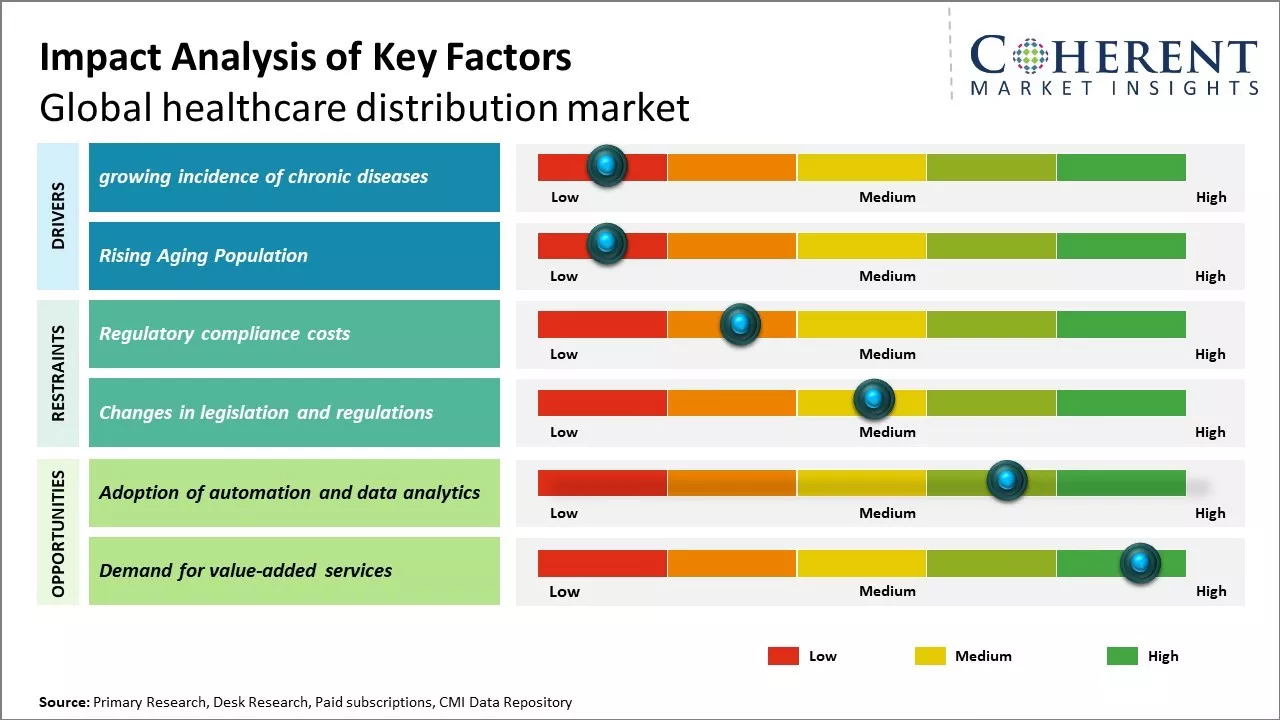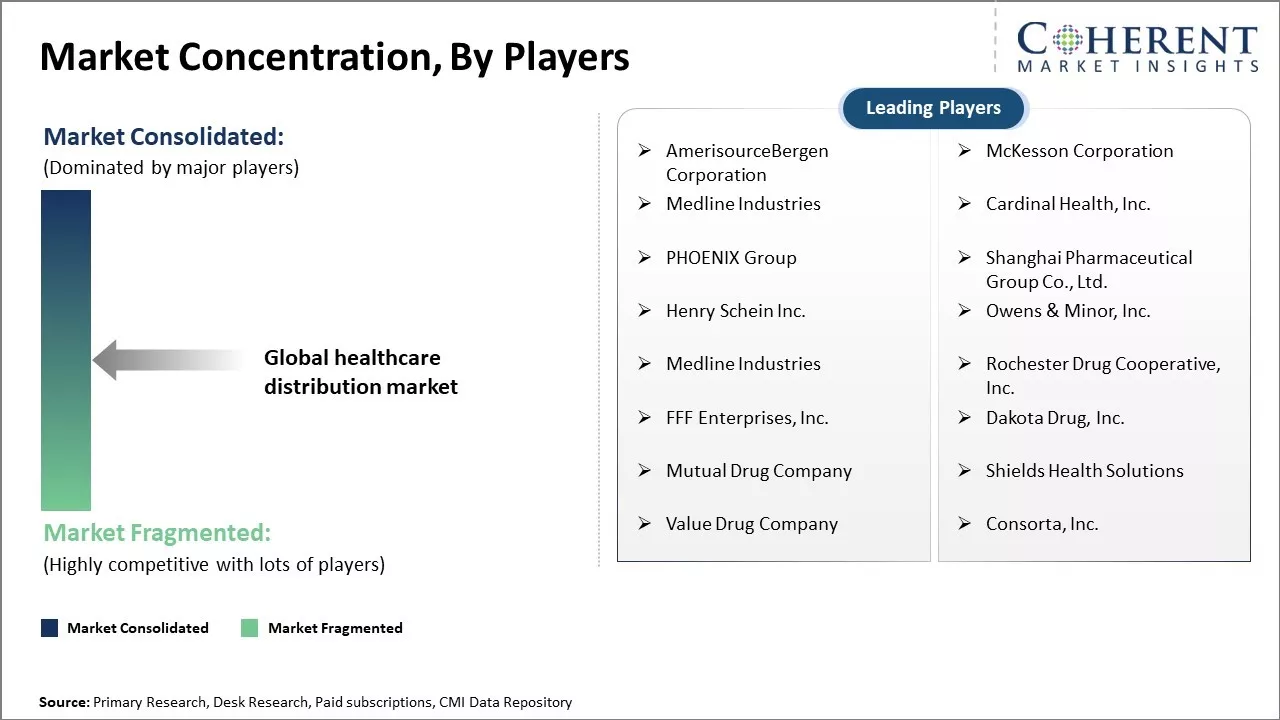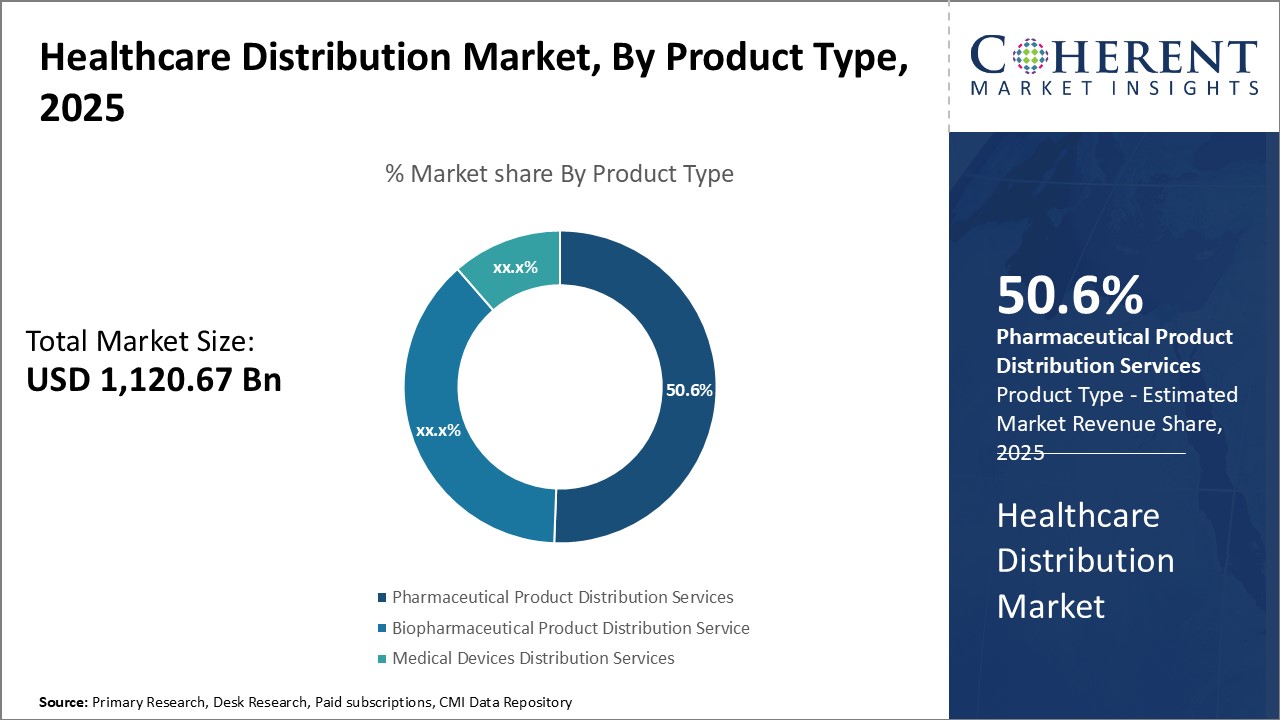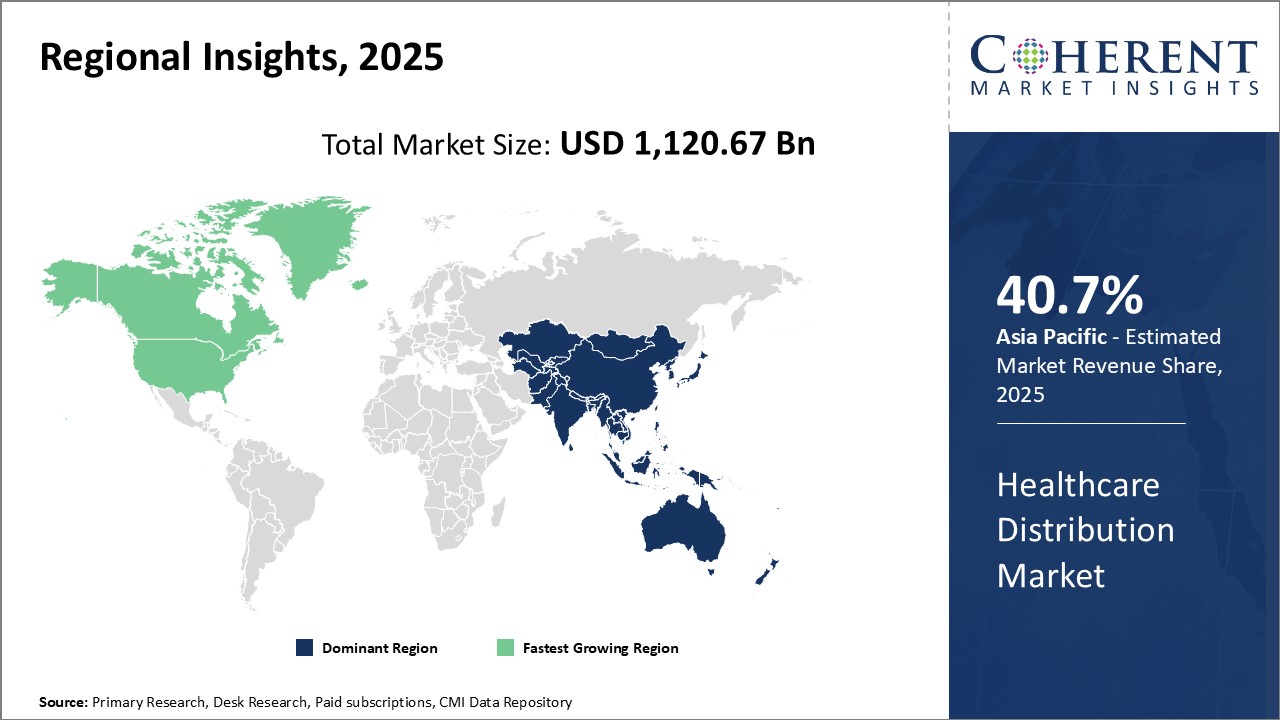Healthcare Distribution Market Size and Trends
Global healthcare distribution market is estimated to be valued at USD 1,120.67 Bn in 2025 and is expected to reach USD 1,765.68 Bn by 2032, exhibiting a compound annual growth rate (CAGR) of 6.7% from 2025 to 2032.

Discover market dynamics shaping the industry: Download Free Sample
Rising healthcare costs, increasing chronic diseases, growing prevalence of lifestyle diseases, booming online distribution channels, and expanding medical infrastructure can boost demand for pharmaceutical and medical devices distribution services globally. Countries are spending more on healthcare to provide universal coverage to their citizens, thus, increasing the volume of healthcare products requiring efficient distribution. Key players are investing in innovative technologies such as blockchain, IoT, and analytics to improve supply chain visibility and deliver products safely and quickly. This helps them to expand their customer base and gain market share.
Growing incidence of chronic diseases
Rising prevalence of chronic diseases across the globe can drive the healthcare distribution market growth. As per the World Health Organization, chronic diseases are the leading cause of death and disability worldwide, accounting for over 70% of all deaths annually. Chronic conditions like cardiovascular diseases, cancer, respiratory diseases and diabetes require long term medical treatment and management over a period of time. This has boosted demand for various pharmaceutical drugs, medical devices, diagnostic equipment and other supplies that are needed to effectively treat such chronic illnesses. As more number of people will suffer from long term health issues, there will be need for ensuring regular and reliable supply of these medical commodities to hospitals, pharmacies, home healthcare providers and other points of care locations. This propels healthcare supply chain companies and medical product distributors to expand their infrastructure and streamline distribution networks. For instance, according to Diabetes Atlas.org in 2021, approximately 536.6 million people had diabetes, with projections indicating this figure will increase to 642.7 million by 2030. Rising prevalence of chronic diseases such as diabetes boosts demand for pharmaceuticals available through retail pharmacies. In 2022, according to the data published by National Institution of Chronic Disease and Data, nearly 60% of American adults are affected by at least one chronic disease, and approximately 40% have multiple chronic conditions (MCC). Conditions like diabetes, cancer, and cardiovascular disease are major contributors to morbidity rates in the U.S.
Market Concentration and Competitive Landscape

Get actionable strategies to beat competition: Download Free Sample
Rising aging population
Rising aging population can increase healthcare spending worldwide. People aged 65 years and above require more medical care and are more vulnerable to various chronic diseases like cancer, diabetes, cardiovascular issues, and others. According to some estimates, the number of people aged 65 years or older globally is projected to increase from about 524 million in 2010 to nearly 1.5 billion in 2050. Rising aging population will boost demand for various healthcare services as well as medical devices and pharmaceutical products. The healthcare distribution industry plays a vital role in ensuring an uninterrupted supply of these medical commodities to healthcare providers and patients in a timely manner. With national healthcare budgets under tremendous strain, efficient distribution network becomes even more important to reduce wastage and optimize resource utilization. Rising aging population can influence healthcare distribution industry players to scale up their infrastructure and capabilities.
Key Takeaways from Analyst:
Growing patient pool for chronic diseases and increasing generic drug consumption can boost demand for pharmaceutical products distribution. New product launches by big pharmaceutical companies focusing on niche therapies can offer market growth opportunities. However, price pressures due to drug price control regulations across various countries can hamper the market growth.
North America currently dominates the global healthcare distribution market, owing to the well-established pharmaceutical industry and growing healthcare expenditure in the U.S. Asia Pacific region is expected to witness the fastest growth due to factors such as rising medical tourism, healthcare infrastructure investments, and growing generic market in India and China.
Stringent regulations and entry barriers for new distributors in developed countries like the U.S. and Japan may challenge the growth of small players. Moreover, paradigm shifts towards specialty drugs from conventional drugs distribution can impact certain established distributors. Expanding footprint in emerging markets and providing value-added services like inventory management, apart from traditional distribution services, can offer market growth opportunities. Rising pharmaceutical demand worldwide can drive the healthcare distribution market Growth.
Market Challenges: Regulatory compliance costs
Regulatory compliance costs can hamper the global healthcare distribution market growth. Complying with various regulations related to drug distribution, security and storage, data privacy, and healthcare standards requires extensive resources for training, documentation, audits and certification. For players in the healthcare distribution industry, the regulatory burden has been steadily rising over the past decade. Strict compliance is necessary as any lapses could directly impact patient well-being and safety. However, maintaining compliance with a complex web of global, regional and local regulations increases operational expenses substantially for companies. Significant investments must be made towards dedicated teams for regulatory research and process documentation. Frequent audits and upgrades as regulations evolve also impose recurring compliance costs. This can act as major restraint for small and mid-sized distributors to scale and expand geographically. The additional regulatory overheads also reduce the competitive advantage larger players previously had through economies of scale. As per the World Health Organization (WHO) Data, nearly half of low and lower-middle income countries reported that high distribution costs constrained access to life-saving medicines in remote areas in 2021.
Market Opportunities: Adoption of automation and data analytics
The global healthcare industry has been ramping up efforts to integrate new digital technologies like automation and data analytics across supply chain operations. This comes at a time when the demand for healthcare has never been higher due to rising disease burdens and an aging population. Automation and data analytics have the potential to completely transform workflows and boost efficiency in healthcare distribution. By digitizing manual, repetitive tasks through robotics process automation, distribution centers can achieve greater speeds and accuracy in order picking, packing and shipping. As per WHO, telemedicine adoption was increased during the COVID-19 pandemic, thus, offering new opportunities for automated management of online healthcare consultations and prescription refills. Leveraging data analytics tools, distributors can gain rich insights into demand patterns, inventory levels, transportation routes and more across their networks. This enables more accurate forecasting of medical product requirements for the long tail of medications. It also allows for optimized logistics planning through technologies like GPS fleet tracking and dynamically optimized delivery routes. In 2021, according to the report published by the UK Department of Health, remote patient monitoring solutions aided by AI led to a 15% reduction in emergency room visits for chronic disease patients during the pandemic. This reduced physical contact and enhanced safety. If these digital interventions can be integrated with distribution workflows, these may lead to lower costs, better resource planning and improved access over the long run.

Discover high revenue pocket segments and roadmap to it: Download Free Sample
In terms of Product Type, Pharmaceutical Product Distribution Services segment contributes the highest share of the market owning to focus on prescription drugs
By product type, pharmaceutical product distribution services segment is estimated to contribute the highest market share of 50.6% in 2025, due to its focus on prescription drugs. Prescription drugs represent the bulk of medicinal treatments for various diseases and medical conditions. As populations age and lifestyle diseases increase around the world, there will be huge demand for prescription pharmaceuticals. Pharmaceutical distributors play a vital role in transporting prescription drugs from their manufacturing facilities to a vast network of retail pharmacies, hospitals, clinics, and other points of care. These maintain extensive warehouse and logistics operations to efficiently store and transport temperature-sensitive drugs worldwide. Their scale and infrastructure enable reliable, timely delivery of prescription medicines to patients. The prescription drug supply chain has become increasingly global and complex. Distributors help navigate international trade regulations and facilitate the movement of drugs across borders. These additionally provide value-added services like inventory management, packaging, and education to pharmacies and facilities. All of these factors are crucial for ensuring patients worldwide can access the prescription treatments they need. There will be huge demand for prescription drugs due to aging populations and increasing accessibility in developing nations. Pharmaceutical distributors are well-positioned to maximize this market potential through innovative technologies and data-driven solutions.
In terms of By End User, Hospital Pharmacies segment contributes the highest share of the market owing to high volume needs
By end user, hospital pharmacies segment is estimated to contribute the highest market share of 40.5% in 2025, due to the high volume needs of this setting. As front-line points of medical treatment, hospitals require huge, uninterrupted supplies of various drugs, devices, and other medical products. Hospital pharmacies dispense medications to thousands of inpatients daily as well as provide medications for outpatient prescriptions and procedures. These stock an immense range of drugs to effectively treat all kinds of emergencies and health issues. Ensuring sufficient supply is critical as hospitals operate 24/7 with no room for stockouts. Compared to other points of care, hospitals also consume medical devices, equipment, and disposable supplies at the highest rate. From intensive care equipment to simple bandages, their needs are immense and diverse. Moreover, many drugs and devices used in hospital have stringent storage and transport conditions like refrigeration. The scale, complexity, and urgency of hospitals’ supply chain needs make pharmaceutical and device distributors a valuable partner. These maintain deep inventory tailored to hospitals’ formularies and maintain reliable just-in-time delivery. Should emergency supply issues occur, distributors’ sales representatives and 24/7 responsiveness help mitigate patient care disruptions.
Regional Insights

Need a Different Region or Segment? Download Free Sample
North America dominates the global healthcare distribution market with an estimated market share of 40.7% in 2025, due to strong presence of major players and a well-established healthcare industry and infrastructure. The U.S. hosts the headquarters of top healthcare distributors. Players in the region have strong logistics and supply chain capabilities due to the large geographical presence, helping them distribute products swiftly across borders within North America. Many regional players also have significant exports to other growing markets like Latin America and Asia Pacific, further enhancing their footprint. However, pricing pressures from payers are mounting in the U.S. and Canada could affect distributor margins.
The Asia Pacific region has emerged as the fastest growing market for healthcare distribution due to rapidly developing economies, rising healthcare expenditures and improving access. China represents a major opportunity due to its large population size and government initiatives to strengthen the domestic healthcare industry. Several multinational players have entered partnerships with local Chinese companies and set up manufacturing units in the country to address the growing needs. Outside of China, other Southeast Asian countries like India, Indonesia and Vietnam showcase promising growth trends due to young demographic structure and increasing focus on universal healthcare. While regulatory framework and quality related issues present challenges, Asia Pacific's healthcare distribution sector is expected to flourish due to expansion of private insurance coverage and rising medical tourism.
Market Report Scope
Healthcare Distribution Market Report Coverage
| Report Coverage | Details | ||
|---|---|---|---|
| Base Year: | 2024 | Market Size in 2025: | USD 1,120.67 Bn |
| Historical Data for: | 2020 To 2024 | Forecast Period: | 2025 To 2032 |
| Forecast Period 2025 to 2032 CAGR: | 6.7% | 2032 Value Projection: | USD 1,765.68 Bn |
| Geographies covered: |
|
||
| Segments covered: |
|
||
| Companies covered: |
AmerisourceBergen Corporation, McKesson Corporation, Medline Industries, Cardinal Health, Inc., PHOENIX Group, Shanghai Pharmaceutical Group Co., Ltd., Henry Schein Inc., Owens & Minor, Inc., Medline Industries, Rochester Drug Cooperative, Inc., FFF Enterprises, Inc., Dakota Drug, Inc., Mutual Drug Company, Shields Health Solutions, Value Drug Company, Consorta, Inc. |
||
| Growth Drivers: |
|
||
| Restraints & Challenges: |
|
||
Uncover macros and micros vetted on 75+ parameters: Get instant access to report
Market Segmentation
- Product Type Insights (Revenue, USD Bn, 2020 - 2032)
- Pharmaceutical Product Distribution Services
- Over The Counter Drugs
- Generic Drugs
- Branded Drugs
- Biopharmaceutical Product Distribution Service
- Recombinant Proteins
- Monoclonal Antibodies
- Blood Products
- Vaccines
- Medical Devices Distribution Services
- Pharmaceutical Product Distribution Services
- End User Insights (Revenue, USD Bn, 2020 - 2032)
- Hospital Pharmacies
- Retail Pharmacies
- Online Pharmacies
- Others
- Regional Insights (Revenue, USD Bn, 2020 - 2032)
- North America
- U.S.
- Canada
- Latin America
- Brazil
- Argentina
- Mexico
- Rest of Latin America
- Europe
- Germany
- U.K.
- Spain
- France
- Italy
- Russia
- Rest of Europe
- Asia Pacific
- China
- India
- Japan
- Australia
- South Korea
- ASEAN
- Rest of Asia Pacific
- Middle East
- GCC Countries
- Israel
- Rest of Middle East
- Africa
- South Africa
- North Africa
- Central Africa
- North America
- Key Players Insights
- AmerisourceBergen Corporation
- McKesson Corporation
- Medline Industries
- Cardinal Health, Inc.
- PHOENIX Group
- Shanghai Pharmaceutical Group Co., Ltd.
- Henry Schein Inc.
- Owens & Minor, Inc.
- Medline Industries
- Rochester Drug Cooperative, Inc.
- FFF Enterprises, Inc.
- Dakota Drug, Inc.
- Mutual Drug Company
- Shields Health Solutions
- Value Drug Company
- Consorta, Inc.
Share
Share
About Author
Manisha Vibhute is a consultant with over 5 years of experience in market research and consulting. With a strong understanding of market dynamics, Manisha assists clients in developing effective market access strategies. She helps medical device companies navigate pricing, reimbursement, and regulatory pathways to ensure successful product launches.
Missing comfort of reading report in your local language? Find your preferred language :
Transform your Strategy with Exclusive Trending Reports :
Frequently Asked Questions
EXISTING CLIENTELE
Joining thousands of companies around the world committed to making the Excellent Business Solutions.
View All Our Clients
